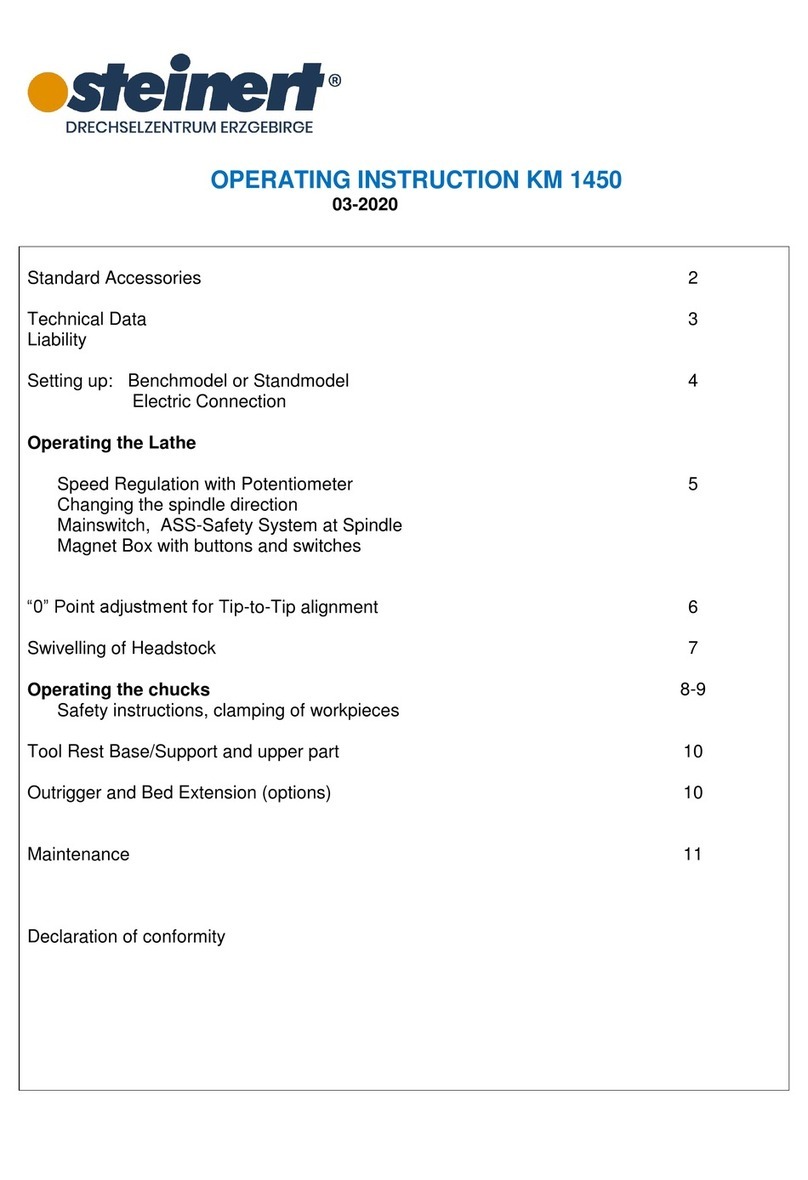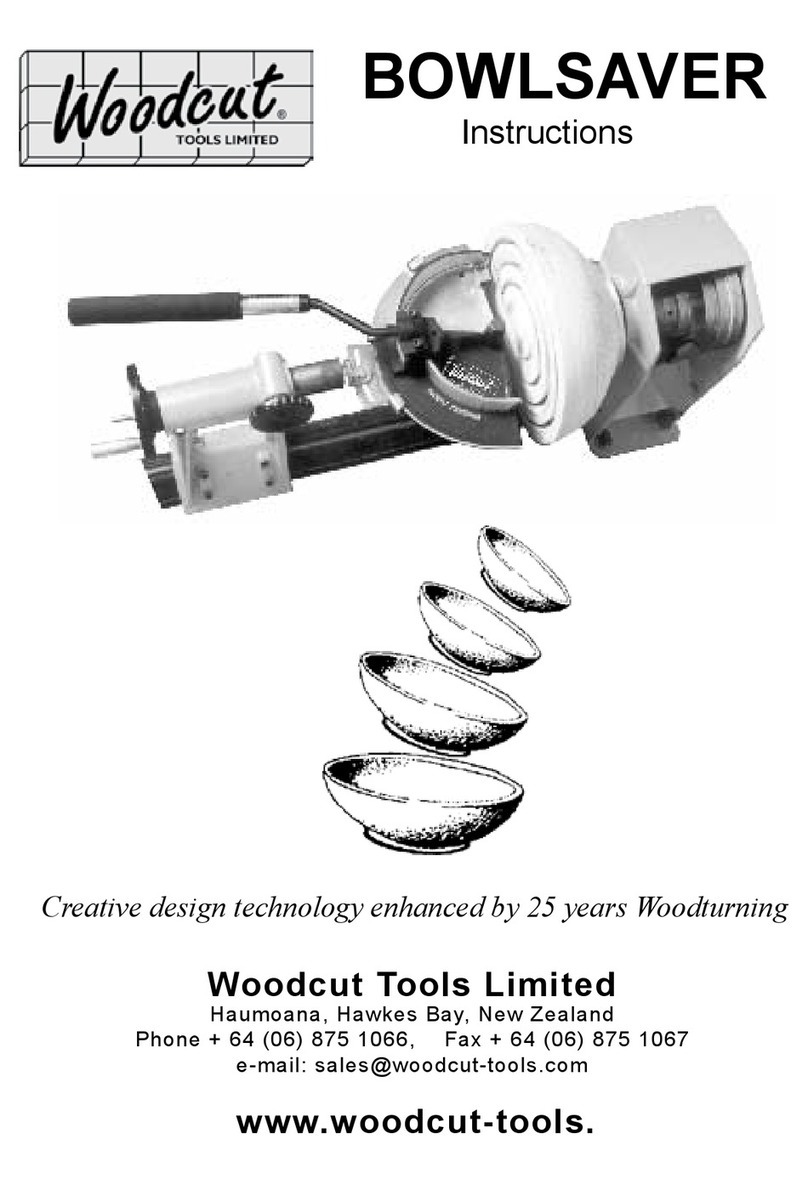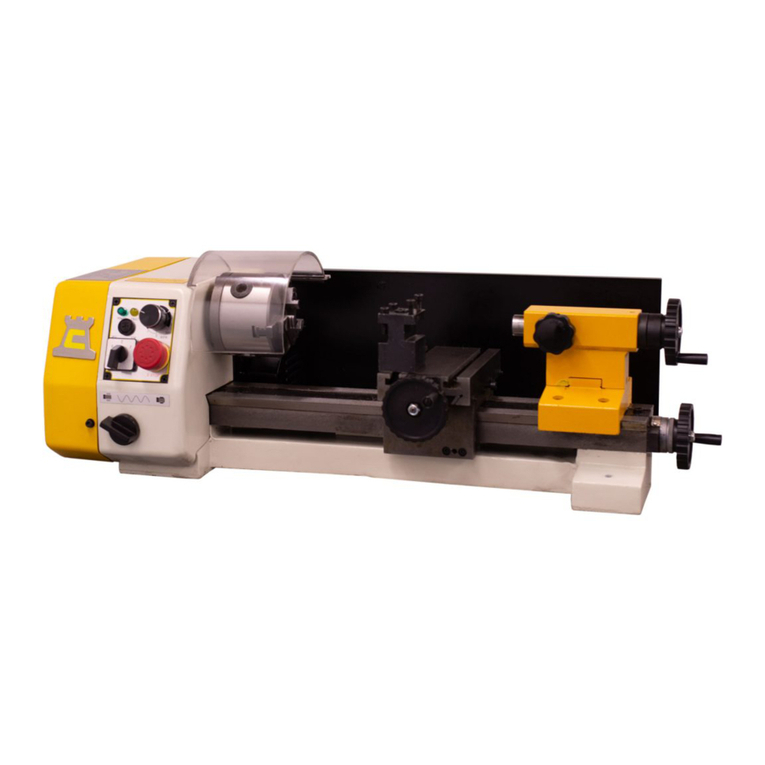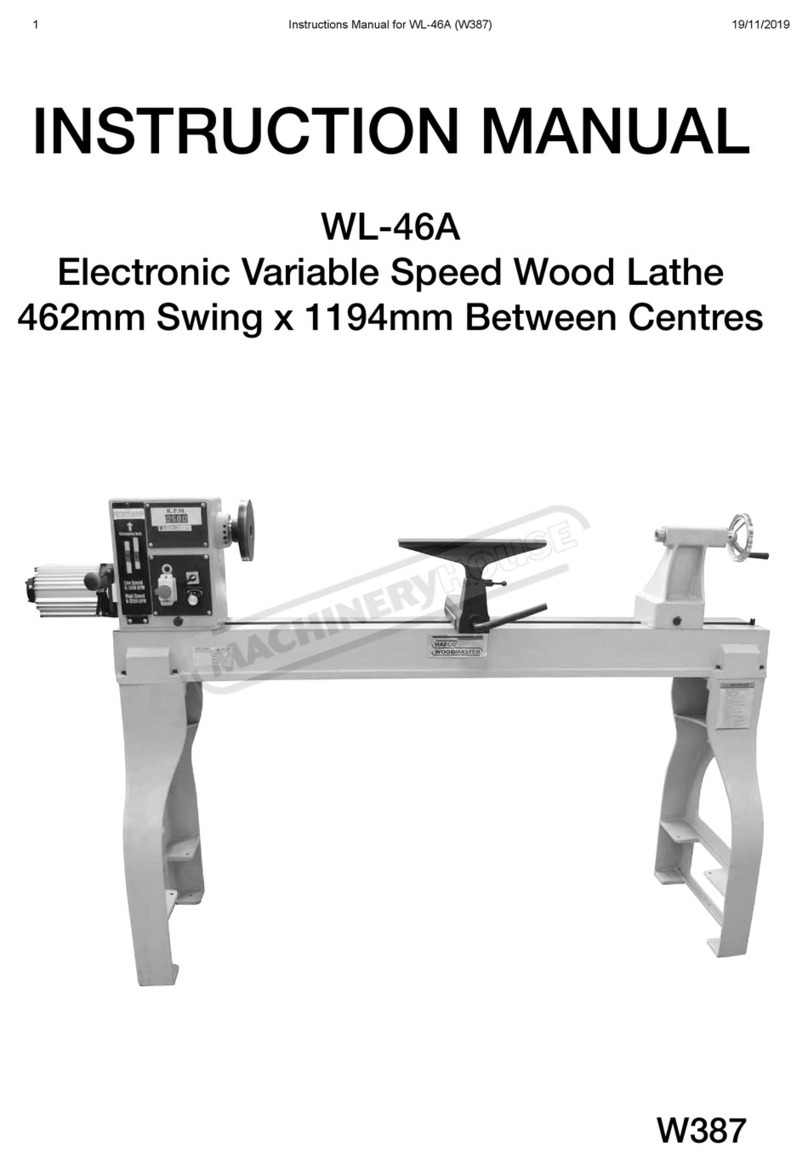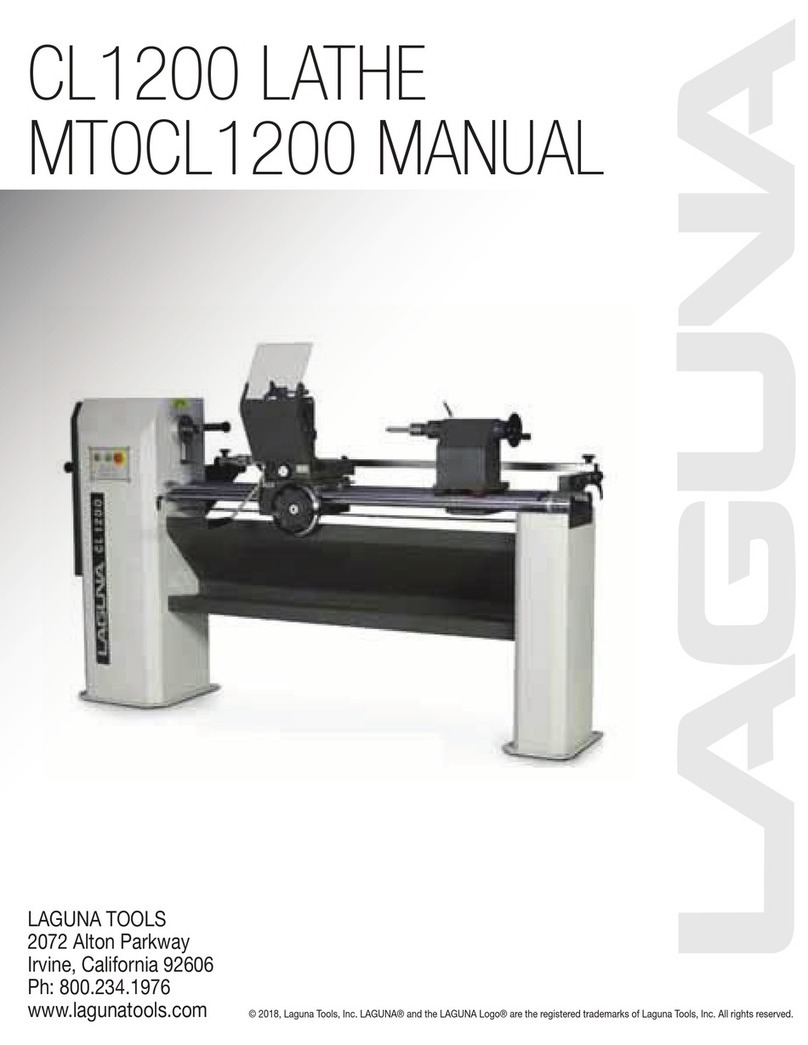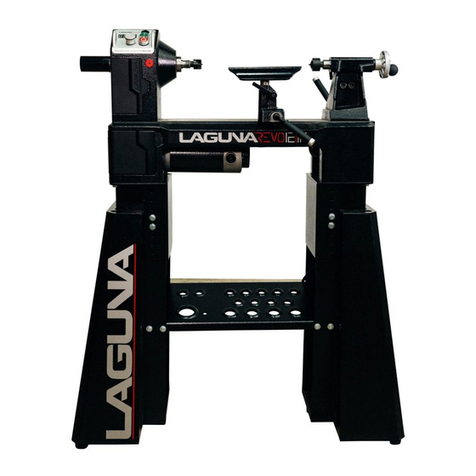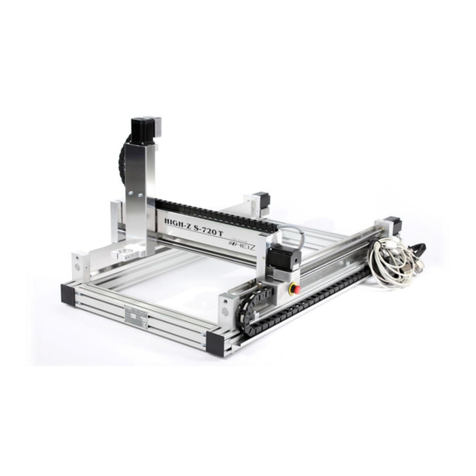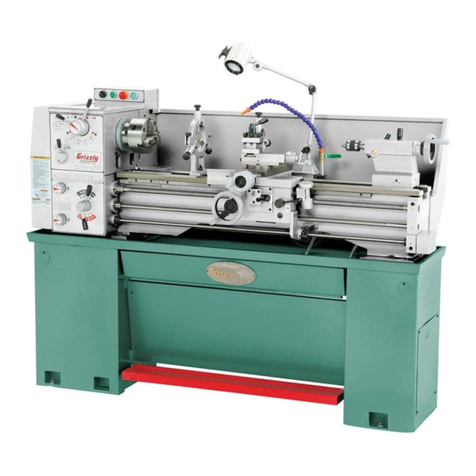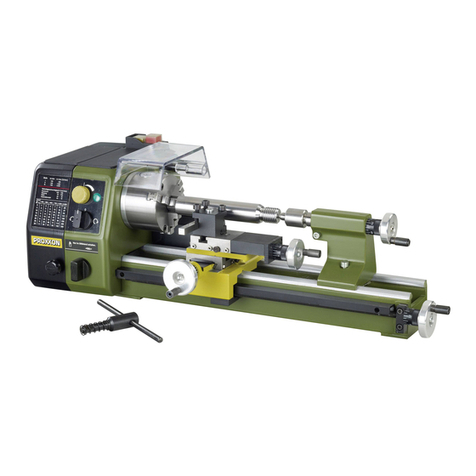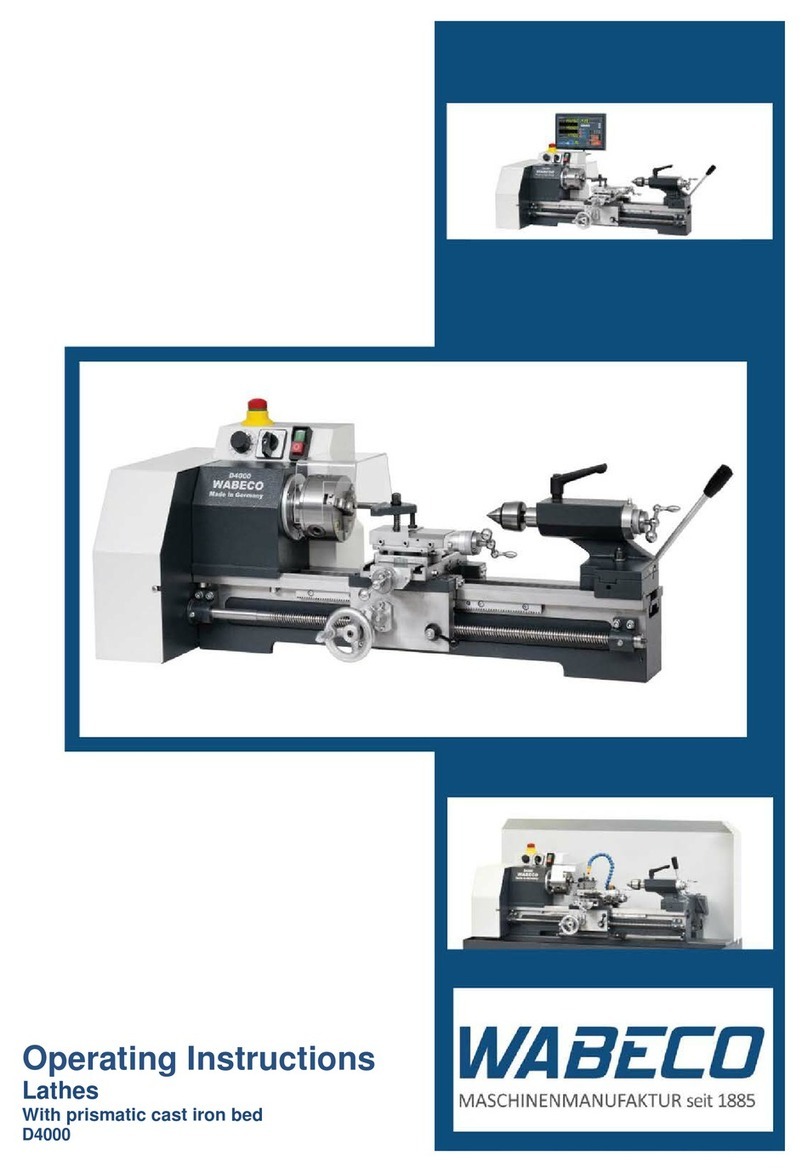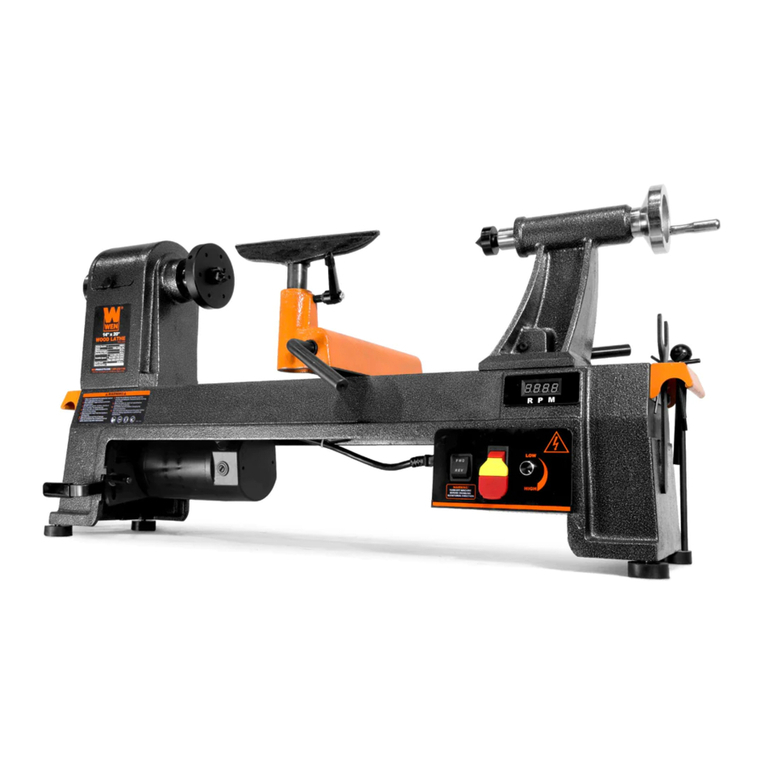steinert KM 3100 SE User manual

OPERATING INSTRUCTIONS KM 3100 SE
STANDARD ACCESSORIES
PAGE 2
TECHNICAL DATA
PAGE 2
Liability
SETTING UP THE MACHINE
PAGE 2
Lifting and Moving
Standard version and extended version
ELECTRIC CONNECTION
Power requirement: 20 Ampere/2,25 kW, fuse protection with circuit breaker B16A
PAGE 3
WORKING WITH THE MACHINE
PAGE 3
Speed Regulation
Spindle Speed and workpiece diameter
Changing the direction of spindle rotation
Emergency off button
PAGE 4
Movable Control Box
Swivelling of headstock
Fine- Adjusting of headstock to “0” Position
Indexing
WORKING WITH CHUCKS
PAGE 5
Operating chucks, prong mandrel, live centre
Clamping the workpiece
Tool Rest
PAGE 6
Outrigger for turning with swivelled headstock
PAGE 6
SAFETY ADVICES AND REGULATIONS
PAGE 6
MAINTENCANCE
PAGE 6
ACCESSORIES AND OPTIONS
Copying Units, Laterial Turning Device, Ball Bearing Device
CE CONFORMITE
PAGE 8

STANDARD FITTINGS
4-prong-mandrel MT2 D=25 mm
for spindle/headstock
4-prong mandrel MT 2 D=35 mm
For spindle/headstock
Live centre MT2/60 °
For tailstock quill
Live centre MT2/with pressring D=20x26 mm
For tailstock quill
Indexing Pin
Mounted fix at spindle nose
never use the indexing pin for locking the spindle!
Tool Rest bottom part
Tool Rest 350 mm
Toolbox with rubber mat
Center knock-out-rod
For prong mandrel
Pin
To loosen chucks
TECHNICAL SPECIFICATIONS
Centre height 280 mm
Distance between centres 850 mm standard
optional 1500 mm with 2nd short bed/3rd foot
optional 2300 mm with 2nd long bed/4 feet
Swing over bed 560 mm
Swing with outrigger 900 mm appor.
Spindle thread M 33 with centering collar, inner cone MK 2
Spindle bearing 2 angular ball bearings front , 1 ball-bearing rear
Indexing System integrated indexing system with scale
Spindle speed rpm 3steps: 40-850 80-1645 125-3025 rpm/min.
Max. permissible workpiece D 500 220 130 mm
Tailstock MK 2 quill taper, stroke 135 mm with scale
Spindle motor 400 V/3 ph/2,2 kW/50 Hz/ connected value B16A
inverter electric mains 230 V/1 ph/50 Hz
Vee-belt poly-vee-belt 10PJ 711
Electrical system with undervoltage and overload protection
Security/Interruption switch inside of vee-belt cover
CEE-Plug 17A, connected 1x230 V electric mains
.
Dimensions L/W/H 185 x 60 x 125 cm max.
Weight 440 –510 –590 kg (depending on centre distance)
Paint grey-white RAL 9002/anthrazit RAL 7016
Warranty 1 year
Subject to change without notice
The machine meets the safety requirements and is CE-conform

LIABILITY
It is not permitted to make alterations or additions to the construction of the machinery supplied, to parts of the machinery supplied
or to accessories. Any warranty and liability claims become void in such case.
SETTING UP THE MACHINE
The anti-rust protection must be removed from the bright machine parts before first use.
The machine is completely installed an mounted.
Place machine at final destination, use a water level to level the machine , adjust with the M12 screws which
are fixed at the feet.
Do not srew/tighten the machine resp. legs to the floor !
LIFTING AND MOVING
Due to the heavy weight of the machine it can be lifted and moved by a forklift or with a pallet truck
Never lift the machine below of the tool box !
If it is necessary to disassemble the machine to move it at the final place: there is a special instruction on request
ELECTRIC CONNECTION
The lathe is supplied complete with a 16A CEE- plug, connected 1 x 230 V
Blue = neutral wire
Brown = L1/Phase
Green/yellow = ground wire
Power requirement 20 Ampere, fuse protection with circuit breaker
Attention
If any other plug than the CEE-plug supplied is used , the connection must be done from a professional electrician
The inverter is mounted at the lefthandside foot
If any work is done at the lefthandside foot pull off the plug from electric mains.
The Inverter parameters are set up for the right rpm in relation to the vee-belt-pulley steps
Any alterations made at the inverter warranty is expired as a result.
SPEED REGULATION
Inside the vee-belt-cover is an additional safety switch to meet the CE-conformity
the machine automatically will stop If the vee-belt-cover is opened or not properly closed
Infinitely variable speed with 3 pulley-steps
changing vee-belt to requested pulley:
loosen the motor clamping by handle, hold motor at grip and move it forwards (loosening of tension)
change vee-belt onto the requested pulley step by “moving” the pulley by hand forward/reverse
fasten clamping lever but do not use too much tension: high tension can cause
vibration, wear of bearings and veebelt, could also cause damage on the motor-schaft
close vee-belt pulley correctly otherwise the motor will not run (safety switch inside)
If working with the lowest speed i.e. 300 rpm/min use the pulley-step with 40-850 rpm/min to ensure
a sufficient power in the lowest speed
Regulation of spindle speed only while the spindle is running!
the spindle speed is controlled by an inverter
start the spindle running
turn speed regulation knob to change speed
clockwise = increasing of speed
anticlockwise = decreasing of speed
speed is shown on the speed digital diagram
Before the machine is switched it is recommended first to check if the Potentionmeter is adjusted to “Zero”
SPINDLE SPEED AND WORKPIECE DIAMETER
The maximum permissible peripheral speed = 3.000 U for a maximum workpiece diameter of 130 mm
Watch the stickers on headstock for the adjusted speed and the max. workpiece diameter

CHANGING TURNING DIRECTION = ROTATION OF SPINDLE
to righthanded rotation, clockwise
correct turning direction is anticlockwise, lefthanded rotation
the flip switch/or selector for forward/reverse switch is integrated at the movable box.
For adjusted turning direction watch the sticker on the headstock
when changing the turning direction the inverter will automatically slow down the speed:
spindle starts slow in opposite direction, speed increases again as adjusted before
Caution to meet safety regulations
adjust the slowest spindle speed before changing the spindle direction.
Chucks may only be used if supplied with optional security locking!
Advise
If the machine is supplied for a school, training or education centre the function of turning direction
can be blocked /disabled by a screw or splint.
Emergency-Off-Button/Mainswitch
The main switch on the headstock is also used as emergency-off-button
If the emergency-off-button was pressed down the button must be turned to activate electric power.
MOVABLE OPERATING BOX
The box is equipped with a “magnet” and can be placed at any position onto the lathe bed
Switches with following functions
Green button = “on”
Red button = “off”
Speed regulator or potentiometer = rotable knob :
Clockwise = increasing the rpm
Anti-clockwise = decreasing the rpm
Turning direction of spindle fwd/rev
Attention: the correct working direction for turning is lefthand i.e. anticlockwise !
SWIVELLING OF HEADSTOCK
the headstock can be swivelled in 6 different positions: 0/60/90/120/180/270°
switch machine off, never turn headstock if motor is switched on
loosen the headstock fixing lever on lefthand side of headstock
loosen headstock fixing pin on front , pull it out
rotate the headstock to one of the 6 possible positions:
take care of your fingers, do not squeeze them between lathe bed
push in the pin until it engages automatically into the given position
at least tighten the fixing pin and the headstock fixing lever again

STOP ADJUSTMENT FOR HEADSTOCK
It prevents the headstock moving lengthways if the tailstock is used as counter pressure for
big and heavy parts
Caution:
If headstock shall be moved or swivelled the clamping plate with hexagon screw must be removed !
FINE ADJUSTMENT OF HEADSTOCK FOR “ZERO-POSITION” TIP TO TIP
Step One: release the headstock clamping lever sideways
unscrew the adjustment bolt until it
gets loose
Pull down the sliding stop
between the lathe cheeks

Push the sliding stop in direction to the lefthand side
(lefthand = seen from frontside of spindle)
at least tighten the headstock clamping lever and screw in the adjustment bolt again
The tips are now correctly in alignment a requirement for exact boring work or turning of writing utensils
CAUTION: before you move or swivel the headstock
The sliding stop must be pushed upwards until its end stop
We also recommend to loosen lever of spindle headstock before
If the Fine Adjustment has been misplaced by force (wrong handling)
it is possible to re-adjust the fine adjustment as follows:
insert in 4-prong mandrel into the spindle of headstock
insert live centre into the tailstock quill
move tailstock in direction to the headstock and clamp it
move quill with live centre by turning the handwheel of tailstock until it touches the tip of prong mandrel
move gently the headstock (loose the clamping lever!) until both tips are in alignment
clamp headstock lever
unscrew slightly ! the both hexagon socket screw M6 x 12 from sliding stop
push it in lefthand direction against the inner cheek of lathe bed
tighten both screws M6 x 12
INDEXING SYSTEM AT SPINDLE
The indexing pin is fixed on headstock, never use the indexing pin to lock the spindle
or for loosen chucks
In the pulley of the spindle are made 36 borings with numbers 1-36
Indexing is done be the fixed mounted black locking pin on top of headstsock which is adjusted
In the requested boring.
f.e. workpiece with 9 tiwsts or flutings: 36:9= 4 , lock the pin after each 4th boring (4,8,12,….)
Safety Advice
Do not switch on spindle motor while the indexing pin is locked!
The indexing pin may not be used as locking of spindle to loosen chucks!

OPERATING CHUCKS, PRONG MANDREL AND LIVE CENTRE
The chucks are mounted on the external thread M 33 of the spindle, which is having a centering collar
Switch off spindle motor
lock spindle with fixing pin (below of spindle nose)
screw on the chuck, surface of thread must be close and plan ! to the centering collar, fasten it properly
handtight by using the pin
Caution: remove the pin before switching on spindle
Do not use spindle motor power to fasten your chuck: you might get problems unscrewing the
chuck from spindle
If direction of spindle is changed to righthanded rotation secure the chuck against
running off from spindle with the security ring
security nut for chuck seat: option
The prong mandrel on spindle/headstock is knocked out with the long supplied bar
The live centre on tailstock comes out automatically :
Loosen the clamping lever on top of quill
turn handwheel until centre is released from quill, hold centre by hand to avoid falling out
CLAMPING THE WORKPIECE
Turning between centres with the 4-prong-mandrel and live centre:
Roughly centre the workpiece at both ends outside the lathe (make bearings last longer)
that markings are visible.
Press the driver prongs firmly into the workpiece by turning the hand wheel.
Tighten the set screws for the tail stock and the quill.
Overhung turning with chucks
Changing of spindle direction may not be used, otherwise the security system
to fix the chuck against running off from the spindle must be ordered (option)
Cone-shaped chuck: Taper turn the workpiece to suit the chuck diameter and drive it in with heavy blows.
Heureka-chuck: Drive the face of the unmachined workpiece into the chuck so that the sharp edge penetrates
approx. 10-15 mm . Maximum work length 200 mm. Most suitable for soft wood.
Face plate: Secure the wooden discs with wooden screws through the bores provided.
Disc-chuck: Screw the workpiece into the wooden screw (if necessary, drill core hole. Wooden discs can be
used to limit the depth of penetratin of the screw).
Jaw-chucks: Increased risk to operator with jaws which project beyond the chuck body. Remove the tightening
key before starting the machine.
div.chucks i.e. Nova Chuck, Super Nova etc. see separate operating manual
TOOL REST
move toolrest close to the workpiece , correct position from time to time if workpiece is turned+
to smaller dimension
we recommend you to turn the spindle with clamped workpiece before by hand to watch if the
Workpiece does not touch the tool rest
after checking true running, switch on spindle motor
move and correct tool rest position only if the spindle motor is switched off
OUTRIGGER=EXTERNAL TURNING ATTACHMENT (Option)
instruction and photo is supplied with the outrigger
.

SAFETY REGULATIONS
The belt guard must be reclosed after each change of V-belt position, motor does not run if vee-belt cover
is not properly closed
Before the machine is switched on:Turn Potentiometer always to “0”
Spindle speed must be checked against the maximum permissible workpiece diameter.
Large, out-of-balance workpieces must be machined at minimum speed,
cut them by a bandsaw octagonal to decrease out-of-balance
All clamping levers i.e. spindle-/tailstock, tool rests etc must be tightened before beginning to work,
any operating pins /keys must be removed from chucks or spindle!
MAINTENANCE
The machine requires no special maintenance.
The bearings are sealed at both sides and are life-time protected with high performance grease.
The Angular Ball bearing retainer ring strengthened from fiber glass Polyamid is applicable for continious
temperatures up to +120°C.
A temperature of 70° is uncritical as per manufacturers information.
Bright parts should be oiled occasionally to prevent corrosion, f.e. Balistol or similar product can also be used.
Expecially if constantly green and wet wood is turned and to safe the life time of your machine
clean the machine immediately after turning, wipe dry bright parts and oil them i.e. lathe bed, spindle etc.
Indexing pin, excenter shaft of tool rest, quill and spindle should be oiled between 4-6 month
to ensure true running and prevend seizing up.
ACCESSORIES, ATTACHMENTS, OPTIONS, COPYING UNITS
We refer to our Accessory Catalogue and our web-page www.drechslershop.de
Drechselzentrum Erzgebirge - steinert®
Heuweg 4
09526 Olbernhau
Tel./Phone: +49 (0)37360-6693-0
Fax/Fax: +49 (0)37360-6693-29
mail [email protected]
shop www.drechslershop.de
webseite www.drechslershop.de/drechselbaenke/killinger

ORIGINAL DECLARATION OF CONFORMITY
KILLINGER declares that the following listened machines have been designed in compliance with:
89/392 EEC/DIN EN292-1/DIN EN 292-2/DIN EN 294/DIN EN 349/DIN EN 418 and 72/23 EEC/89/336 EEC/86/188
EEC.
Wood Turning Lathe KM 1000 Nova
Wood Turning Lathe KM 1400 SE
Wood Turning Lathe KM 1500 SE
Wood Turning Lathe KM 2000 S/SE
Wood Turning Lathe KM 2500 S/SE
Wood Turning Lathe KM 3000 S/SE
Wood Turning Lathe KM 3100 S/SE
Wood Turning Lathe KM 6000 S
Copying-Lathe KM 5000 S
Copying-Lathe KM 5000 SM
Copying-Lathe KM 5000 S-Hydro
Copying-Lathe KM 6000 SM
Copying-Lathe KM 6000 S-Hydro+Hydro Plus
Copying-Lathe KM 7000 S-Hydro
Copying Lathe KM 8000 CNC
Milling Lathe KM 9000 S-Hydromill
Copying Unit KM 100
Copying Unit KM 300
Copying Unit KM 500
Barley Twist Machine KM 150
Level of sound pressure according to 86/188/EED & 89/392 EEC, measured according to EN 50144:
Lpa sound pressure 66 dB (A)
Lwa acoustic power 81 dB (A)
The maximum peripheral speed of the Lathe may not exceed 30 m/s.
Drechselzentrum Erzgebirge - steinert®
Heuweg 4
09526 Olbernhau
Deutschland
Roland Steinert/ Inhaber

CE-Konformitätserklärung / CE - Declaration of Conformity
für / for
Handdrechselbank / Woodturning lathe:
killinger® KM3100 Nr.: / No.: _________________
Wir / We: DRECHSELZENTRUM ERZGEBIRGE –steinert®
Heuweg 4, 09526 Olbernhau, Deutschland/Germany
Tel./Phone: +49 (0)37360-6693-0
Fax/Fax: +49 (0)37360-6693-29
E-Mail/Email: [email protected]
Internet/Internet: www.drechslershop.de
erklären, dass die zuvor benannte Maschine den Anforderungen der Maschinen-Richtlinie 2006/42/EG entspricht.
declare that this machine named above meets the essential health and safety requirements of machinery directive
2060/42/EC.
Elektrische und elektronische Komponenten entsprechen den Anforderungen der Niederspannungsrichtlinie
2006/95/EC und der EMV-Richtlinie 2004/108/EG.
Electrical control and its Components are in accordance with the Low Voltage (2006/95/EC) and EMC (2004/108/EC)
Directives
Angewandte harmonisierte Normen / Harmonized standards applied:
EN ISO 12100 EN ISO 3746
EN ISO 13857 EN ISO 11202
EN ISO 13850 EN ISO 11204
EN 13849-1 EN 60 204 T 1
EN 1088
Diese Erklärung wird verantwortlich für DRECHSELZENTRUM ERZGEBIRGE - steinert® abgegeben durch:
This declaration is made for and on behalf of DRECHSELZENTRUM ERZGEBIRGE - steinert® by:
Roland Steinert (Inhaber / Owner)
Unterschrift:_______________________________________
Table of contents
Other steinert Lathe manuals
Popular Lathe manuals by other brands
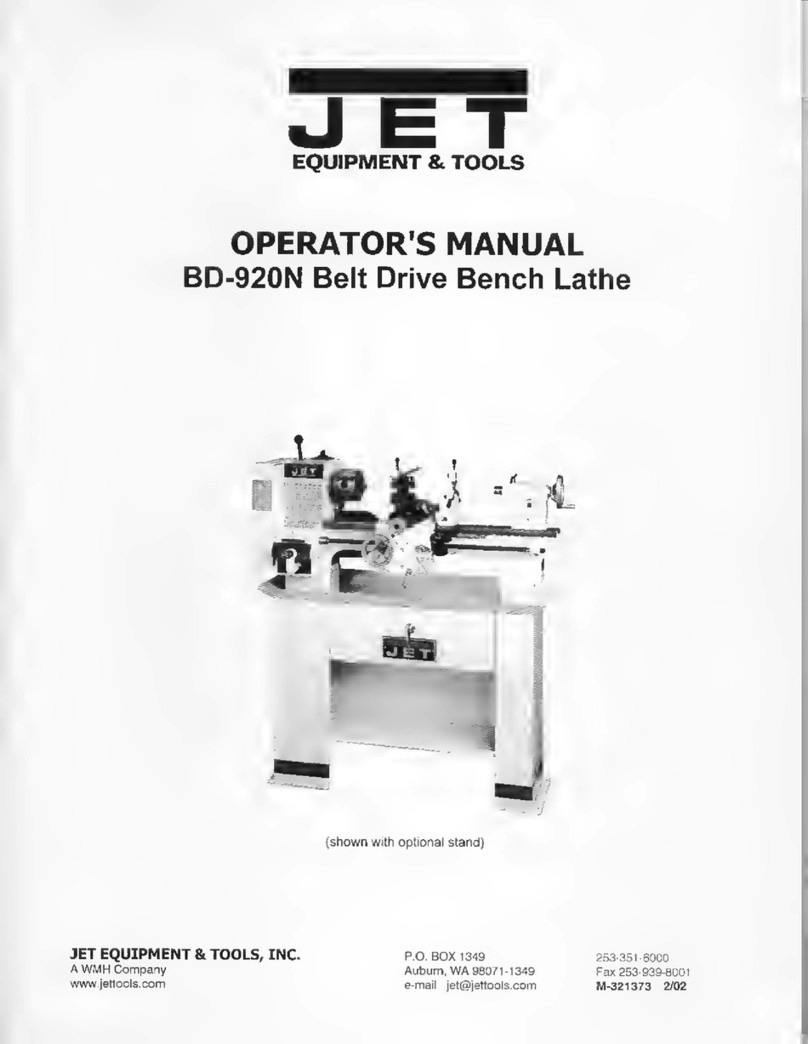
Jet
Jet BD-920N Operator's manual

Sealey
Sealey SM1100.V2 instructions
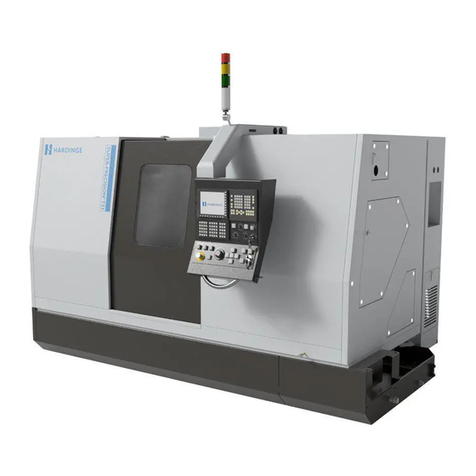
Hardinge
Hardinge T-51 Installation and Extended Storage Instructions
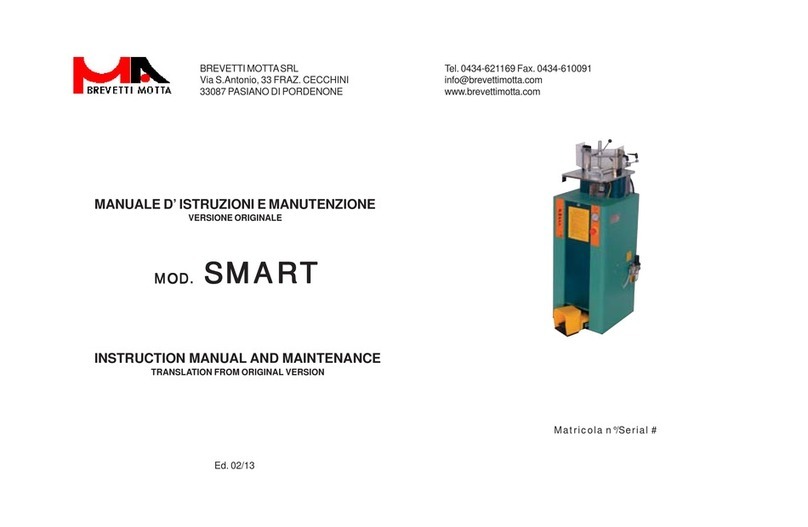
Brevetti Motta
Brevetti Motta SMART Instruction manual and maintenance
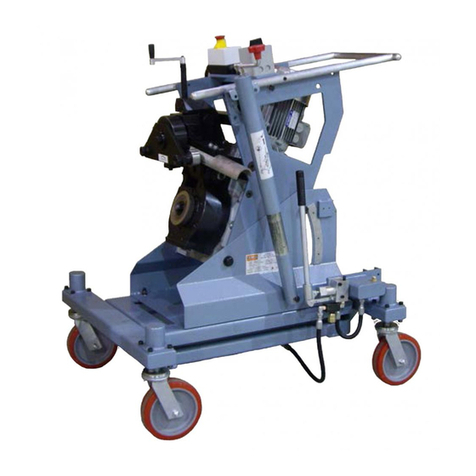
GULLCO
GULLCO KBM-28U PARTS LIST & OPERATING INSTRUCTIONS

System 3R
System 3R 3R-770.6-1 instructions

